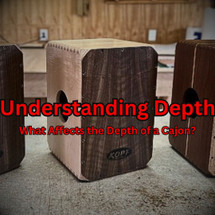Posted by Steve Head on 3rd Jun 2025
Understanding Depth: What Affects the Depth of a Cajon?
When musicians talk about the "depth" of a cajon, they’re usually referring to the richness and fullness of the instrument’s low-end sound. Depth is what gives the cajon its powerful bass tones, making each hit feel substantial and resonant. It’s the characteristic that makes the cajon not just heard, but felt. As the owner of Kopf Percussion, I’ve spent years perfecting the depth of my cajons to ensure they deliver that deep, satisfying bass that musicians crave. In this blog post, I’ll explore the factors that I believe affect the depth of a cajon and how these elements can be adjusted to achieve the sound you’re looking for.
1. Material of the Tapa
- Impact on Depth: In my opinion, the material used for the tapa (the front playing surface) is a major factor in determining the depth of a cajon’s sound. Softer woods like mahogany or walnut tend to produce a deeper, more resonant bass because they allow for greater vibration and sustain. These woods emphasize the lower frequencies, contributing to a fuller, richer sound. Harder woods, such as birch or maple, may produce a brighter tone with less emphasis on the low end, resulting in a sound that is less deep but more focused.
- Example: I often select softer woods for the tapa when a deep, bass-heavy sound is desired. These materials help create the rich, resonant tones that many players seek in a cajon.

2. Thickness of the Tapa
- Impact on Depth: The thickness of the tapa also plays a crucial role in shaping the depth of the cajon. A thicker tapa generally produces a deeper sound because it vibrates more slowly and retains more of the low-end frequencies. Thinner tapas, while more responsive, tend to vibrate more quickly, producing a brighter sound with less emphasis on depth.
- Example: For musicians looking for a cajon with pronounced bass tones, I might recommend a thicker tapa to enhance the depth and fullness of the sound.

3. Size and Shape of the Cajon
- Impact on Depth: The overall size and shape of the cajon significantly affect its depth. Larger cajons with more internal volume tend to produce deeper, more resonant bass tones because the increased airspace allows the sound waves to develop fully. The shape, particularly the depth of the cajon, also influences how sound waves move within the instrument, contributing to the overall richness and depth of the sound.
- Example: At Kopf Percussion, I design each cajon with specific dimensions to optimize depth. A larger, deeper cajon is ideal for players who want a powerful, resonant bass that can anchor the rhythm in any musical setting.

4. Body Material and Construction
- Impact on Depth: The material and construction of the cajon’s body play a crucial role in determining its depth. Dense woods like walnut or maple are often used for the body because they enhance the low-end frequencies, producing a deeper, more resonant sound. The construction of the cajon, including the thickness of the walls and the internal bracing, also affects how much depth is produced. A well-constructed cajon with solid, dense materials will naturally emphasize the bass tones, creating a sound that is both deep and powerful.
- Example: At Kopf Percussion, I use high-quality hardwoods for the body to ensure that the cajon delivers a rich, deep sound. The internal construction is designed to maximize resonance and minimize unwanted vibrations, resulting in a fuller, more satisfying tone.

5. Sound Hole Size and Placement
- Impact on Depth: The size and placement of the sound hole are key factors in shaping the depth of the cajon’s sound. A larger sound hole allows more air to escape, which can reduce the depth by lessening the resonance of the low frequencies. Conversely, a smaller sound hole retains more of the bass frequencies within the cajon, contributing to a deeper, fuller sound. The placement of the sound hole, typically at the back of the cajon, also affects how the sound is projected and how the depth is perceived by the listener.
- Example: I experiment with different sound hole designs at Kopf Percussion to achieve the optimal balance of depth and projection. A smaller sound hole placed strategically can enhance the richness and depth of the cajon’s tone, making it more resonant and powerful.

6. Snare System and Its Impact on Depth
- Impact on Depth: The snare system inside the cajon can either enhance or detract from the depth of the sound. If the snare wires or strings are too tight or too prominent, they can introduce a higher-pitched buzzing sound that competes with the bass frequencies, reducing the overall depth. A well-balanced snare system that complements the bass tones can enhance the depth by adding a subtle texture without overpowering the low end.
- Example: In my S-Series Snare Cajons, the snare system is carefully calibrated to ensure that it complements rather than detracts from the deep, resonant bass tones that define the cajon’s sound.

Conclusion: Enhancing the Depth of Your Cajon
Depth is a crucial characteristic of a cajon’s tone, giving the instrument the power and presence needed to drive the rhythm in many styles of music. By understanding what affects the depth—such as the materials used, the construction—I can tailor your instrument’s sound to achieve the rich, resonant tone you’re looking for. Want to go even deeper?
I’m dedicated to crafting cajons that offer the perfect balance of depth, tone, and resonance. Each cajon is designed with careful attention to detail, ensuring that you get the best possible sound for your music. If you’re interested in exploring my collection of handcrafted cajons and finding the one that’s right for you, check out my offerings here. Let’s work together to create the perfect depth for your playing style.


